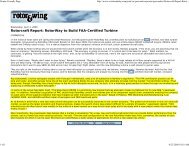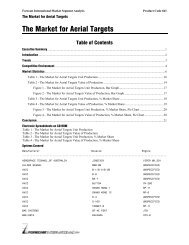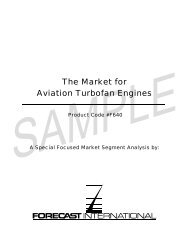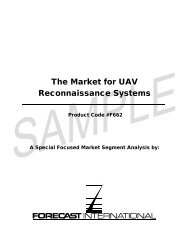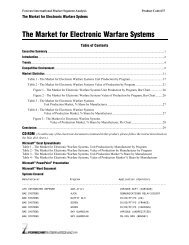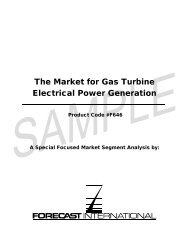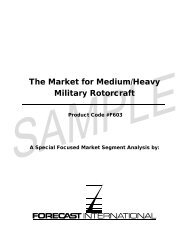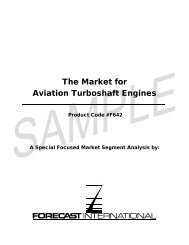The Market for Aviation Turboprop Engines - Forecast International
The Market for Aviation Turboprop Engines - Forecast International
The Market for Aviation Turboprop Engines - Forecast International
You also want an ePaper? Increase the reach of your titles
YUMPU automatically turns print PDFs into web optimized ePapers that Google loves.
<strong>The</strong> <strong>Market</strong> <strong>for</strong><br />
<strong>Aviation</strong> <strong>Turboprop</strong> <strong>Engines</strong><br />
Product Code #F641<br />
A Special Focused <strong>Market</strong> Segment Analysis by:
<strong>Aviation</strong> Gas Turbine <strong>Forecast</strong><br />
Analysis 3<br />
<strong>The</strong> <strong>Market</strong> <strong>for</strong> <strong>Aviation</strong> <strong>Turboprop</strong><br />
<strong>Engines</strong>: 2010-2019<br />
Table of Contents<br />
Executive Summary .................................................................................................................................................2<br />
Introduction................................................................................................................................................................2<br />
Trends..........................................................................................................................................................................2<br />
<strong>The</strong> Competitive Environment...............................................................................................................................3<br />
<strong>Market</strong> Statistics .......................................................................................................................................................3<br />
Table 1 - <strong>The</strong> <strong>Market</strong> <strong>for</strong> <strong>Aviation</strong> <strong>Turboprop</strong> <strong>Engines</strong><br />
Unit Production by Headquarters/Company/Program 2010 - 2019 ..................................................5<br />
Table 2 - <strong>The</strong> <strong>Market</strong> <strong>for</strong> <strong>Aviation</strong> <strong>Turboprop</strong> <strong>Engines</strong><br />
Value Statistics by Headquarters/Company/Program 2010 - 2019.................................................10<br />
Figure 1 - <strong>The</strong> <strong>Market</strong> <strong>for</strong> <strong>Aviation</strong> <strong>Turboprop</strong> <strong>Engines</strong><br />
Unit Production 2010 - 2019 (Bar Graph) ...............................................................................15<br />
Figure 2 - <strong>The</strong> <strong>Market</strong> <strong>for</strong> <strong>Aviation</strong> <strong>Turboprop</strong> <strong>Engines</strong><br />
Value of Production 2010 - 2019 (Bar Graph).........................................................................15<br />
Table 3 - <strong>The</strong> <strong>Market</strong> <strong>for</strong> <strong>Aviation</strong> <strong>Turboprop</strong> <strong>Engines</strong><br />
Unit Production % <strong>Market</strong> Share by Headquarters/Company 2010 - 2019 ....................................16<br />
Table 4 - <strong>The</strong> <strong>Market</strong> <strong>for</strong> <strong>Aviation</strong> <strong>Turboprop</strong> <strong>Engines</strong><br />
Value Statistics % <strong>Market</strong> Share by Headquarters/Company 2010 - 2019.....................................17<br />
Figure 3 - <strong>The</strong> <strong>Market</strong> <strong>for</strong> <strong>Aviation</strong> <strong>Turboprop</strong> <strong>Engines</strong><br />
Unit Production % <strong>Market</strong> Share by Headquarters 2010 - 2019 (Pie Chart) ...........................18<br />
Figure 4 - <strong>The</strong> <strong>Market</strong> <strong>for</strong> <strong>Aviation</strong> <strong>Turboprop</strong> <strong>Engines</strong><br />
Value Statistics % <strong>Market</strong> Share by Headquarters 2010 - 2019 (Pie Chart)............................18<br />
Conclusion ...............................................................................................................................................................19<br />
* * *<br />
©2010 December 2010
Product Code F641<br />
<strong>The</strong> <strong>Market</strong> <strong>for</strong> <strong>Aviation</strong> <strong>Turboprop</strong> <strong>Engines</strong><br />
PROGRAMS<br />
<strong>The</strong> following reports are included in this section: (Note: a single report may cover several programs.)<br />
Europrop <strong>International</strong> TP400-D6<br />
General Electric CT7 (<strong>Turboprop</strong>)<br />
Honeywell TPE331<br />
OMSK Aircraft Engine Bureau <strong>Aviation</strong> <strong>Turboprop</strong>s<br />
Pratt & Whitney Canada PT6A<br />
Pratt & Whitney Canada PW100 Series<br />
Rolls-Royce AE 2100<br />
Rolls-Royce Model 250 (<strong>Turboprop</strong>)<br />
Rolls-Royce T56/501<br />
©2010 December 2010
Product Code F641<br />
<strong>The</strong> <strong>Market</strong> <strong>for</strong> <strong>Aviation</strong> <strong>Turboprop</strong> <strong>Engines</strong><br />
This analysis of the turboprop engine market covers the<br />
factors that will affect engine production worldwide<br />
over the next 10 years. Included in this discussion are<br />
Introduction<br />
industry trends that affect the competitive environment,<br />
varied market statistics, and individual manufacturers'<br />
engine programs.<br />
©2010
<strong>Aviation</strong> Gas Turbine <strong>Forecast</strong><br />
Pratt & Whitney Canada PW100 Series<br />
Outlook<br />
P&WC launches new regional turboprop program<br />
New PW127M powers ATR 600 series<br />
300<br />
250<br />
200<br />
Unit Production <strong>Forecast</strong><br />
2010-2019<br />
150<br />
100<br />
50<br />
0<br />
2010 2011 2012 2013 2014 2015 2016 2017 2018 2019<br />
Units 265 243 225 220 232 237 237 251 259 255<br />
Units<br />
Orientation<br />
Description. Advanced-design, two-spool,<br />
centrifugal-flow, free-turbine turboprop engine<br />
generating from 1,500 shp to approximately 5,000 shp<br />
(1,118-3,728 kW), with growth potential to 6,000 shp<br />
(4,474 kW).<br />
Sponsor. Development of the PW100 series was<br />
privately sponsored by the prime contractor.<br />
Power Class. 1,800-5,000 shp (1,342-3,728 kW).<br />
Status. In production <strong>for</strong> several large regional<br />
transport aircraft and some military variants, as well as<br />
<strong>for</strong> the Canadair CL-415 firefighting aircraft.<br />
Total Produced. As of September 2010, an estimated<br />
8,694 engines in the PW100 series had been built.<br />
Application. Regional airline, utility, and executive<br />
transport aircraft; special-purpose aircraft. Current or<br />
proposed applications include the following (see also<br />
Variants/Upgrades section):<br />
Engine Maximum Takeoff <strong>Engines</strong> per<br />
Variant Rating Application Airframe<br />
PW115 1,500 shp (1,118 kW)(a) Embraer EMB 120 (production completed) 2<br />
PW118/118A 1,800 shp (1,342 kW) Embraer EMB 120 (production completed) 2<br />
PW119B/C 2,180 shp (1,625 kW) Dornier/Fairchild-Dornier Do 328-110/120/200 (comp.) 2<br />
PW121 2,150 shp (1,603 kW) Bombardier Q100/de Havilland DHC-8-100 (comp.) 2<br />
PW121A 2,200 shp (1,417 kW) Aero <strong>International</strong> (Regional) ART 42-300/400 (comp.) 2<br />
PW123B 2,500 shp (1,864 kW) Bombardier Q300 2<br />
PW123C/D 2,150 shp (1,603 kW) Bombardier Q200 2<br />
PW123AF 2,380 shp (1,774 kW) Bombardier/Canadair CL-215T, CL-415 2<br />
PW124B 2,400 shp (1,789 kW) Aero <strong>International</strong> (Regional) ART 72 (prod. comp.) 2<br />
PW127 2,750 shp (2,051 kW) Aero <strong>International</strong> (Regional) ART 72-100 (prod. comp.) 2<br />
PW127E 2,160 shp (1,610 kW) Aero <strong>International</strong> (Regional) ART 42-500 2<br />
PW127J 2,750 shp (2,050 kW) Xi'an Y7-200A/MA60 2<br />
PW127F 2,920 shp (2,177 kW) Aero <strong>International</strong> (Regional) ART 72-500 2<br />
CASA C-295M 2<br />
PW150A 4,580 shp (3,415 kW) Bombardier Q400 2<br />
5,000 shp (3,728 kW)(b) Shaanxi Y-8F600 (in development) 4<br />
(a) For initial aircraft. Engine model has been deleted from Type Certificate.<br />
(b) Power output yet to be identified. A 5,000-shp output is projected by <strong>Forecast</strong> <strong>International</strong>.<br />
©2010 November 2010
Page 2<br />
<strong>Aviation</strong> Gas Turbine <strong>Forecast</strong><br />
Pratt & Whitney Canada PW100 Series<br />
Price Range. PW123, $800,000. PW127, $920,000.<br />
PW150, $1.3 million. All estimates are in 2010 U.S.<br />
dollars.<br />
Competition. <strong>The</strong> PW100 series of aviation<br />
turboprops faces competition from the Honeywell<br />
TPE331-15AW at 1,650 shp (1,230 kW) and the<br />
General Electric CT7 at 1,700-2,000 shp<br />
(1,268-1,491 kW). <strong>The</strong> PW150A competes with the<br />
Rolls-Royce AE 2100 at 4,000-6,000 shp<br />
(2,983-4,474 kW).<br />
Contractors<br />
Prime<br />
Pratt & Whitney Canada<br />
http://www.pwc.ca, 1000 Marie-Victorin Blvd, Longueuil, J4G 1A1 Quebec, Canada,<br />
Tel: + 1 (450) 677-9411, Fax: + 1 (450) 647-3620, Prime<br />
Subcontractor<br />
Aircraft Parts Corp<br />
Hamilton Sundstrand<br />
Honeywell Aerospace Yeovil<br />
Parker Aerospace Gas Turbine<br />
Fuel Systems Division<br />
http://www.apcmfg.com, 100 Corporate Dr, Holtsville, NY 11742 United States,<br />
Tel: + 1 (631) 289-0077, Email: esandler@apcmfg.com (Starter-Generator)<br />
http://www.hamiltonsundstrand.com, 4747 Harrison Ave, PO Box 7002, Rock<strong>for</strong>d, IL<br />
61125-7002 United States, Tel: + 1 (815) 226-6000 (Integrated Drive Generator)<br />
http://www.honeywell.com/sites/aero/, Bun<strong>for</strong>d Ln, Yeovil, BA20 2YD Somerset, United<br />
Kingdom, Tel: + 44 1935 457 181, Fax: + 44 1935 427 600,<br />
Email: sales.yeovil@honeywell.com (Main Engine Oil Cooler)<br />
http://www.parker.com/ag, 9200 Tyler Blvd, Mentor, OH 44060 United States,<br />
Tel: + 1 (440) 954-8100, Fax: + 1 (440) 954-8199 (Fluid Management System)<br />
Comprehensive in<strong>for</strong>mation on Contractors can be found in <strong>Forecast</strong> <strong>International</strong>’s “<strong>International</strong> Contractors” series. For a detailed description,<br />
go to www.<strong>for</strong>ecastinternational.com (see Products & Samples/Governments & Industries) or call + 1 (203) 426-0800.<br />
Contractors are invited to submit updated in<strong>for</strong>mation to Editor, <strong>International</strong> Contractors, <strong>Forecast</strong> <strong>International</strong>, 22 Commerce Road, Newtown,<br />
CT 06470, USA; rich.pettibone@<strong>for</strong>ecast1.com<br />
Technical Data<br />
Design Features. P&WC PW100 series engines<br />
have the following design features:<br />
Intake. Integral structural annular intake surrounding<br />
output shaft. Intake duct to nacelle located under<br />
gearbox.<br />
Low-Pressure Compressor. Single-stage LP<br />
centrifugal compressor driven by a single axial-flow,<br />
low-pressure turbine or gas generator turbine. Impeller<br />
is <strong>for</strong>ged/machined titanium. Pressure ratio estimated at<br />
4.3:1.<br />
PW150 has a three-stage, axial-flow LP compressor.<br />
High-Pressure Compressor. Single-stage centrifugal<br />
compressor driven by the Stage 1 gas generator or<br />
high-pressure turbine. Pressure ratio estimated at 4.3:1,<br />
with a total compressor mass flow of 15 lb/sec <strong>for</strong> the<br />
PW115. Total pressure ratio <strong>for</strong> the PW115 is 14.3,<br />
while larger versions have a greater pressure ratio of up<br />
to 17:1. All casings are titanium, with the complex<br />
investment cast intercompressor case also composed of<br />
titanium.<br />
<strong>The</strong> PW150 has a single centrifugal HP compressor.<br />
Combustor. Single annular, reverse-flow combustor<br />
designed <strong>for</strong> high-temperature operation. Composed of<br />
sheet metal liner and outer liners with 14 piloted<br />
air-blast atomizing fuel nozzles. PW150 also has a<br />
reverse-flow annular combustor.<br />
High-Pressure Turbine. Single high-pressure<br />
axial-flow turbine is composed of 47 directionally<br />
solidified cast MAR-M200 blades. HP nozzle vane<br />
segments are investment cast in IN792 Mod 5A<br />
material, with the cooling insert <strong>for</strong> each vane cast in<br />
IN625. HP blade has CPW 362A duplex aluminide<br />
coating. Interstage turbine duct is investment cast in<br />
IN713.<br />
Low-Pressure Turbine. Single uncooled LP turbine<br />
drives the LP compressor via concentric shafting, and is<br />
composed of investment cast IN100 blades and an<br />
integrally cast nozzle vane ring of IN792 material<br />
(PW124/125A engine has LP stator cooling). Turbine<br />
inlet temperature (TIT) estimated in the 2,100-2,300°F<br />
November 2010
<strong>Aviation</strong> Gas Turbine <strong>Forecast</strong> Page 3<br />
Pratt & Whitney Canada PW100 Series<br />
(1,149-1,260°C) range, depending upon variant and<br />
customer power requirements. <strong>The</strong> gas generator<br />
diffuser is cast and HIPed in IN718. Nozzle is coated<br />
with CPW 43 aluminide.<br />
PW150 has a single LP turbine.<br />
Power Turbine. Two-stage, axial-flow power turbine<br />
drives the propeller gearbox through the third internal<br />
shaft. Stage 1-2 blades are cast in IN713LC, while the<br />
Stage 1 PT nozzle vane ring is integrally cast in IN713<br />
and the second PT ring is composed of 54 individually<br />
cast IN625 vanes.<br />
<strong>The</strong> PW150 has a single power turbine.<br />
Propeller Gearbox. Two-stage reduction unit with a<br />
20,000-rpm-input high-speed double helical and two<br />
reduction lay-shafts and gears, which drive the bull gear<br />
and propeller shaft at 1,200-1,300 rpm. Casing is cast<br />
magnesium. Gearbox ratings are 1,600 and 2,000 shp,<br />
respectively, <strong>for</strong> the PW115 and PW120. Alternate<br />
ratings <strong>for</strong> the PW115 and PW120 of 1,980 and<br />
2,380 shp, respectively, are offered as well.<br />
Bearings. Seven main engine anti-friction bearings; no<br />
intershaft bearings.<br />
Accessories. Starter and generator are mounted above<br />
and just <strong>for</strong>ward of the HP case to the HP spool. <strong>The</strong><br />
hydromechanical control unit is also HP spool-mounted.<br />
Optional alternator, hydraulic pump, and Woodward<br />
propeller governor and governor pump are mounted to<br />
individual pads. <strong>The</strong>re is a single lubrication system <strong>for</strong><br />
the gearbox and gas generator, with one pressure pump<br />
and two scavenge pumps with associated bypass filters<br />
and screens to prevent cross-contamination.<br />
Controls. Electronic fuel control connected to a<br />
hydromechanical system <strong>for</strong> maximum economy over<br />
the power range. Integrated engine monitoring system<br />
to minimize maintenance requirements. <strong>The</strong> PW150<br />
has a Hamilton Sundstrand dual-channel Full Authority<br />
Digital Engine Control (FADEC) system.<br />
Dimensions. <strong>The</strong> approximate dimensions and weights of the P&WC PW100 series (through the PW127G) are as<br />
follows:<br />
Metric Units<br />
U.S. Units<br />
Length 2,134 mm 84 in<br />
Width 863 mm 34 in<br />
Height 620 mm 24.4 in<br />
Diameter (maximum) 636-838 mm 25-33 in<br />
Weight, dry (including essential accessories)<br />
PW118/118A/118B 401.4 kg 885 lb<br />
PW119B/119C 402.3 kg 887 lb<br />
PW120/120A/121/121A 434.1 kg 957 lb<br />
PW123/123B/123C/123D/123E 453.6 kg 1,000 lb<br />
PW123AF 467.2 kg 1,030 lb<br />
PW124B/125B/126A/127/127E/127F/127G 480.8 kg 1,060 lb<br />
<strong>The</strong> approximate dimensions and weight of the P&WC PW150 are as follows:<br />
Metric Units<br />
U.S. Units<br />
Length 2,423 mm 95.4 in<br />
Diameter (maximum) 1,136 mm 44.7 in<br />
Weight, dry 689.9 kg 1,521 lb<br />
PW118A. <strong>The</strong> PW118A is an uprated version of the<br />
first PW100, the PW115. This engine variant became<br />
the initial powerplant <strong>for</strong> the EMB 120.<br />
<strong>The</strong> PW118A is essentially a PW115 with PW124<br />
hot-section components, and it has a higher shp<br />
capability <strong>for</strong> increased hot and high-altitude<br />
per<strong>for</strong>mance. This engine has been offered as a retrofit<br />
engine <strong>for</strong> the EMB 120.<br />
Variants/Upgrades<br />
PW119. <strong>The</strong> PW119 was tailored <strong>for</strong> the Dornier 328<br />
program by adding compressors from the PW124. <strong>The</strong><br />
engine was already equipped with the PW124's hot<br />
section.<br />
PW123. <strong>The</strong> PW123 was basically designed <strong>for</strong> the<br />
DHC-8-200/300 (now Q200/Q300) series of regional<br />
turboprops. <strong>The</strong> PW123AF is optimized <strong>for</strong> the<br />
demanding operational requirements of the<br />
CL-215T/415 firefighting aircraft. Hot section<br />
inspection is specified as necessary only "on condition."<br />
©2010 November 2010
Page 4<br />
Pratt & Whitney Canada PW100 Series<br />
<strong>Aviation</strong> Gas Turbine <strong>Forecast</strong><br />
Time between overhauls is quoted by P&WC as 8,000<br />
hours <strong>for</strong> all variants except the PW123AF, which has a<br />
TBO of 2,500 hours.<br />
PW127. <strong>The</strong> PW127 series is optimized <strong>for</strong><br />
hot-and-high operation.<br />
<strong>The</strong> PW127 produces 5-10 percent more power than<br />
PW124 variants (the PW124 is no longer produced) in<br />
takeoff, climb, and cruise. <strong>The</strong> engine incorporates a<br />
higher mass-flow low-pressure compressor (LPC) of<br />
increased temperature capability. <strong>The</strong> higher<br />
temperatures result from use of single-crystal blades in<br />
the LPC.<br />
Hot section inspection is specified as necessary only "on<br />
condition." TBO is quoted by P&WC as 6,000 hours<br />
<strong>for</strong> all PW127 variants.<br />
PW130. <strong>The</strong> PW130 was proposed as a model that<br />
would add another stage to the power turbine along with<br />
other gas generator changes to achieve 3,000 shp<br />
(2,237 kW), or about 3,150 eshp. <strong>The</strong> engine was<br />
originally expected to be certificated and become<br />
available by 1994. <strong>The</strong> engine model was planned to be<br />
mated to a Hamilton Standard (now Hamilton<br />
Sundstrand) propfan gearbox and propeller to produce<br />
an estimated 7,500-8,000 lbst. Ef<strong>for</strong>ts on the PW130<br />
were shelved after a more in-depth assessment of the<br />
high end of the large turboprop-powered commuter<br />
aircraft marketplace shifted ef<strong>for</strong>ts to the PW150,<br />
described below.<br />
PW150. A major uprating of the PW100 series, the<br />
basic design is capable of 6,500-7,500 shp<br />
(4,847-5,592 kW). <strong>The</strong> machine is a three-spool freeturbine<br />
engine incorporating three axial low-pressure<br />
compressors and one centrifugal high-pressure<br />
compressor, each driven by a single axial turbine stage;<br />
this model has 75 percent more airflow than other<br />
PW100 models. A dual-channel high-per<strong>for</strong>mance<br />
ignition system is used. <strong>The</strong> 5,000-shp reduction<br />
gearbox used is the helical type found in other PW100s.<br />
<strong>The</strong> engine is equipped with a Hamilton Sundstrand<br />
dual-channel FADEC system, an engine health<br />
monitoring system, and a functionally integrated PEC<br />
(propeller electronic control). <strong>The</strong> PW150 can fit into<br />
the nacelles of other PW100 engines, making retrofit of<br />
PW150s into PW100-powered aircraft a possibility.<br />
Pratt & Whitney Canada estimated that it spent<br />
CAD250 million ($183.3 million) to develop the<br />
PW150.<br />
<strong>The</strong> PW150's first application was the Bombardier<br />
DHC-8-400, <strong>for</strong> which it is derated to 4,830 shp<br />
(3,600 kW). A total of 12 PW150 engines were used in<br />
the engine test program, while another nine were used<br />
<strong>for</strong> the DHC-8-400 certification program. <strong>The</strong> first<br />
production-standard engine was delivered to<br />
Bombardier in May 1997.<br />
Background. Initially developed as the PT7A (an<br />
improved and advanced follow-on to the widely used<br />
PT6A series), the since-redesignated United<br />
Technologies Pratt & Whitney Canada PW100 series of<br />
turboprop engines is the result of extensive design and<br />
development ef<strong>for</strong>ts under an in-house project<br />
designated ADS-604. Among the major factors driving<br />
this program, which was officially launched in 1979,<br />
were the design limitations of the PT6A series, the<br />
availability of advanced metallurgical technology not<br />
suitable to the PT6A, and the growing demand <strong>for</strong><br />
improved specific fuel consumption (SFC) among the<br />
operating community. Testing of a demonstrator engine<br />
under the ADS-604 ef<strong>for</strong>t was initiated in 1979. First<br />
testing on P&WC's Viscount testbed was conducted in<br />
1982, leading to certification in 1983. Revenue<br />
generating service began in December 1984.<br />
<strong>The</strong> PW100 engine family has accumulated more than<br />
85 million flying hours, with engines regularly<br />
achieving over 10,000 hours on-the-wing without a shop<br />
visit.<br />
Program Review<br />
P&WC PW100 Series Applications. Among the<br />
applications <strong>for</strong> the P&WC PW100 turboprop series of<br />
powerplants are the following:<br />
Aero <strong>International</strong> (Regional) ATR Series. <strong>The</strong><br />
twin-engine 46-74 seat ART 42/72 is a joint<br />
development of Aerospatiale of France and Aeritalia of<br />
Italy.<br />
<strong>The</strong> ART 42/72 series has a maximum T-O weight of<br />
47,400 pounds (21,500 kg) and a maximum range of<br />
1,440 nautical miles (2,666 km). Initially geared toward<br />
the 40-49-passenger market, the ART 42 has a high<br />
wing and a T-tail, and is powered by PW120 engines<br />
rated at 2,000 shp, providing 6 percent improvement in<br />
climb rate over the PW115. <strong>The</strong> PW121A was made<br />
available on the ART 42 as an option <strong>for</strong> hot-and-high<br />
applications. <strong>The</strong> maiden flight of the ART 42 was<br />
made in October 1984. U.S. FAA certification was<br />
obtained in October 1985.<br />
<strong>The</strong> ART 42-500, an ART 42 equipped with 2,750-shp<br />
PW127Es, became the predominant version of the<br />
November 2010
<strong>Aviation</strong> Gas Turbine <strong>Forecast</strong> Page 5<br />
Pratt & Whitney Canada PW100 Series<br />
ART 42 after 1995, the year it was certificated. It has a<br />
higher cruising speed (at 305 kt) than the earlier<br />
versions.<br />
Aeritalia and Aerospatiale officially launched the<br />
ART 72 in 1985. This 66-74 seat stretched version uses<br />
the 2,400-shp P&WC PW124/124B engines and made<br />
its initial flight in 1988; it was certificated in 1989.<br />
<strong>The</strong> latest version of the ART 72, the ART 72-500, has<br />
lower interior noise levels than its PW124-powered<br />
predecessor, and an improved cabin air conditioning<br />
system. <strong>The</strong> ART 72-500, launched as the ART 72<br />
Improved and later called the ART 72-210A,<br />
incorporates the 2,920-shp (max takeoff) PW127G<br />
engine <strong>for</strong> improved hot/high, time-to-climb, balanced<br />
field length, and one-engine-out per<strong>for</strong>mance. French<br />
and U.S. FAA certification of this variant were granted<br />
in 1992.<br />
de Havilland DHC-8/Bombardier Q Series. <strong>The</strong><br />
de Havilland DHC-8 series (now Bombardier Q series)<br />
is a twin-engine relative of the four-engined DHC-7.<br />
<strong>The</strong> DHC-8-100's first flight occurred in 1983; the<br />
model was certificated in 1984. <strong>The</strong> larger DHC-8-300<br />
was announced in 1985. It is a 50-56 seat aircraft that is<br />
powered by the PW123 engine variant.<br />
At the 1992 Farnborough Air Show, de Havilland<br />
announced plans to offer "B" models of its<br />
DHC-8-100/200/300 aircraft. <strong>The</strong> Bs offer higher gross<br />
weights, longer range, and improved cabin noise levels.<br />
For improved overall per<strong>for</strong>mance (particularly in<br />
hot-and-high conditions), the DHC-8-100B is equipped<br />
with more powerful PW121s, while the DHC-8-200B<br />
and -300B are equipped with PW123Bs. Most of the<br />
B options are retrofittable.<br />
<strong>The</strong> DHC-8-100, DHC-8-200, and DHC-8-300 are now<br />
referred to as the Bombardier Q100, Q200, and Q300,<br />
respectively.<br />
<strong>The</strong> most recent addition to the DHC-8 line is the<br />
DHC-8-400, now called the Q400. This DHC-8 growth<br />
variant features a 22-foot (6.7-m) fuselage stretch<br />
(beyond the DHC-8-300) to accommodate a maximum<br />
of 74 passengers. <strong>The</strong> aircraft also has a new <strong>for</strong>ward<br />
baggage door, an aft cargo door, and a strengthened<br />
wing/fuselage joint. Cruising speed climbs to 350 knots<br />
(650 kmph). Aircraft rollout occurred in 1997, and<br />
FAA certification was granted in 1999.<br />
<strong>The</strong> PW150 was chosen by Bombardier <strong>for</strong> its<br />
maximum commonality with the other PW100-powered<br />
DHC-8 variants. <strong>The</strong> engines are rated at 4,830 shp <strong>for</strong><br />
this application, driving Dowty six-blade reversiblepitch<br />
propellers.<br />
Canadair (Bombardier) CL-215T/CL-415. <strong>The</strong><br />
twin-engine Canadair CL-215 and CL-415 aircraft are<br />
considered the world's most capable water-bombers.<br />
<strong>The</strong> original piston-powered CL-215 can be re-engined<br />
with turboprop engines. In 1984, the Canadian firm<br />
conducted an engineering study to assess the suitability<br />
of a turboprop retrofit <strong>for</strong> the original P&WC R2800<br />
radial-engined CL-215. In 1986, the PW120 was chosen<br />
to power the CL-215T (approximately $9.5 million <strong>for</strong><br />
engine conversion). Canadair/Bombardier has since<br />
switched to the 2,380-shp (1,774-kW) PW123AF. <strong>The</strong><br />
turbine engines provide pilots an extra margin of power<br />
and safety, while reducing maintenance costs.<br />
Quebec had retrofitted all 19 of its piston-powered<br />
CL-215s by the end of 1995, in addition to Spain's order<br />
<strong>for</strong> 15 retrofit kits <strong>for</strong> its fleet of water bombers. Also,<br />
France ordered 12 CL-415s; Quebec, 8 CL-415s; and<br />
Italy, 4 CL-415s.<br />
New-build PW123AF-powered aircraft are designated<br />
CL-415s. Compared to the CL-215s or CL-215Ts, the<br />
new-build aircraft add fully powered flight controls, a<br />
new cockpit with electronic flight instrument systems,<br />
and 15 percent more water capacity. <strong>The</strong> first CL-415<br />
was delivered in 1994. <strong>The</strong> following countries have<br />
CL-215Ts and/or CL-415s in their inventory: Canada,<br />
23; Croatia, 6; France, 11; Greece, 10; Italy, 14; and<br />
Spain, 15. <strong>The</strong>re are about 70 piston-powered CL-215s<br />
in operation. <strong>The</strong>y are all candidates <strong>for</strong> turbine<br />
conversions.<br />
CASA/IPTN C-295. In 1995, CASA announced plans<br />
to further develop the CN-235, and the stretched (by<br />
3 m) variant that emerged is designated the C-295.<br />
Launched by CASA in mid-1997 and first flown at the<br />
end of that year, this stretched derivative is powered by<br />
P&WC PW127G engines and, compared with the<br />
CN-235, offers a 3.7 percent payload increase, a<br />
15-knot cruise speed increase, and a 70-nautical-mile<br />
range increase.<br />
<strong>The</strong> C-295's maximum takeoff weight is 51,272 pounds<br />
(23,200 kg); its maximum payload is 21,360 pounds<br />
(9,700 kg).<br />
<strong>The</strong> Spanish Air Force launched C-295 sales with an<br />
order <strong>for</strong> nine aircraft in 1999. <strong>The</strong> air arms of Spain<br />
(nine aircraft), Poland (eight units), and Jordan (two)<br />
have ordered the C-295, while a long-pending United<br />
Arab Emirates four-unit contract does not appear to<br />
have been signed yet. Brazil announced in 2002 that it<br />
planned to procure 12 aircraft, but orders have not<br />
followed. <strong>The</strong> South African Air Force reportedly has a<br />
firm requirement <strong>for</strong> as many as 14 aircraft.<br />
©2010 November 2010
Page 6<br />
Pratt & Whitney Canada PW100 Series<br />
<strong>Aviation</strong> Gas Turbine <strong>Forecast</strong><br />
Xi'an Y7/MA60. <strong>The</strong> Xi'an Aircraft Company (Xi'an,<br />
Shaanxi, People's Republic of China) is a<br />
twin-turboprop derivative of the Ukrainian Antonov<br />
An-24 (NATO code: Coke). While the Y-7/Y7-100<br />
aircraft use twin Dongan Engine Manufacturing<br />
Company (DEMC) WJ-5A I turboprops rated at<br />
approximately 2,790 shp (2,080 kW) at T-O, the<br />
Y7-200A uses PW127C engines rated at 2,750 shp<br />
(2,050 kW). Only about five have been built.<br />
Xi'an has developed a new version of the Y7, designated<br />
the MA60. Powered by two 2,750-shp PW127Js, it<br />
weighs approximately 48,000 pounds (21,800 kg, max<br />
takeoff) and has a maximum range of approximately<br />
860 nautical miles (1,600 km). <strong>The</strong> MA60 can<br />
accommodate 56-60 passengers. VIP, freighter, and<br />
mixed cargo/passenger configurations are also available.<br />
Antonov An-140. Ukrainian aircraft builder Antonov<br />
has developed a 46-52 seat regional transport. <strong>The</strong><br />
aircraft's standard engine is the 2,465-shp TV3-117<br />
turboprop, while the 2,500-shp PW127A is being<br />
offered as an option. <strong>The</strong> aircraft's estimated range in<br />
the 52-seat configuration is 1,133 nautical miles<br />
(2,100 km) with the TV3, or 1,349 nautical miles<br />
(2,500 km) with the PW127. <strong>The</strong> aircraft first flew<br />
(with the TV3-117MA) in 1997. <strong>The</strong>re is a license<br />
agreement with Iran <strong>for</strong> production (with the TV3) by<br />
HESA at Isfahan.<br />
Reims <strong>Aviation</strong> in France has held talks with Antonov<br />
about collaborating in the development of a<br />
Westernized version of the -140, using PW127 engines<br />
and, most likely, new avionics and an improved cabin<br />
interior. Russia's Aeroflot airlines has held talks with<br />
Antonov and Aviakor <strong>for</strong> up to 50 P&WC-powered<br />
-140s. Nothing has gone <strong>for</strong>ward on the<br />
PW127-powered version, however.<br />
Shaanxi Y-8F600. Shaanxi Aircraft Company in<br />
China has manufactured its four-engine Y-8 mediumrange<br />
turboprop transport aircraft series since 1986,<br />
including civil transport, drone carrier, and livestock<br />
carrier versions. <strong>The</strong> aircraft are powered by South<br />
Aero-Engine Company WJ-6/6A turboprop engines<br />
developing 4,250-4,500 shp (3,169-3,355 kW). In<br />
1999, P&WC concluded a Memorandum of<br />
Understanding (MoU) with the China <strong>Aviation</strong> Industry<br />
Corp to supply PW150s <strong>for</strong> the Y-8F600. Production<br />
has not yet gone <strong>for</strong>ward, however.<br />
Timetable<br />
Month Year Major Development<br />
Jun 1979 Design initiated<br />
Dec 1980 First gas generator run<br />
Mar 1981 First full engine test<br />
Feb 1982 First test flight<br />
Dec 1983 PW115/PW120 certificated (PW115 dropped Nov 1984)<br />
Jan 1984 Initial deliveries of engines<br />
Feb 1984 First run of the PW124<br />
Dec 1984 PW100 enters revenue service: PW120A on DHC-8-100<br />
Nov 1985 PW124 certification; initial deliveries<br />
Aug 1986 PW118 certificated<br />
Nov 1987 PW118A certificated<br />
Nov 1989 PW126A certificated<br />
Feb 1990 PW124B certificated<br />
Mid- 1991 PW130 ef<strong>for</strong>t put on hold pending market reassessment<br />
May 1993 PW123AF-powered CL-415 receives FAA certification<br />
Dec 1993 Xi'an Y7-200A first flight with PW127<br />
Sep 1995 ART 42-500 with PW127Es certificated<br />
Mid- 1996 PW150 enters testing<br />
Mar 1997 First flight-test of PW150 on Boeing 720 testbed<br />
June 1998 First PW150 engines shipped to Bombardier <strong>for</strong> Dash 8Q-400<br />
Mid- 1999 P&WC MoU with China regarding Y-8F600<br />
May 1999 FAA certification of de Havilland DHC-8-400<br />
2007 Xi'an was reportedly to increase production of MA60<br />
Thru 2016 Continued production of PW100 turboprop series<br />
November 2010
<strong>Aviation</strong> Gas Turbine <strong>Forecast</strong> Page 7<br />
Worldwide Distribution/Inventories<br />
Pratt & Whitney Canada PW100 Series<br />
As of September 2010, an estimated 8,694 PW100 engines had been built, powering more than 2,000 aircraft in<br />
service with 344 operators in 107 countries. <strong>The</strong> largest concentrations are in North America and Europe.<br />
Pratt & Whitney Canada's PW100 series maintains its<br />
domination of the regional transport engine segment, as<br />
it powers the two most popular aircraft from ATR and<br />
Bombardier. <strong>The</strong> ATR 42/72 and Bombardier Q Series<br />
have been the prominent aircraft in the regional<br />
turboprop segment <strong>for</strong> many years, and updates to these<br />
aircraft, along with the inherent efficiency of turboprops<br />
overall, will keep them relevant <strong>for</strong> the <strong>for</strong>eseeable<br />
future.<br />
New ATR Series Flies Upgraded PW127M<br />
ATR's new 600 series aircraft is set to enter service in<br />
2011, and will be the launch plat<strong>for</strong>m <strong>for</strong> the PW127M.<br />
This new variant will offer 5 percent greater power at<br />
takeoff and maximum continuous power settings,<br />
allowing <strong>for</strong> improved per<strong>for</strong>mance in hot-and-high<br />
operations. ATR is considering a new family of<br />
turboprops that would include variants seating up to 90<br />
passengers.<br />
Of the original Q Series, Bombardier's Q400 is the only<br />
type still in production. <strong>The</strong> market has dictated that<br />
bigger is better, leading to the end of the smaller aircraft<br />
in the series. Bombardier has been considering a<br />
stretched Q400 version <strong>for</strong> several years but has not<br />
announced a decision.<br />
Ten-Year Outlook<br />
<strong>Forecast</strong> Rationale<br />
New Regional <strong>Turboprop</strong> Program<br />
In June 2010, Pratt Canada announced the launch of a<br />
demonstrator program <strong>for</strong> a new regional turboprop<br />
engine. Pratt said the engine is an all-new advanced<br />
design intended to provide a double-digit reduction in<br />
fuel burn and environmental emissions. <strong>The</strong> company<br />
has completed the study phase and is moving on to the<br />
demonstrator program. This is somewhat coincidental<br />
with Embraer's exploration of a 100-passenger<br />
turboprop, as the engine would provide the efficiency<br />
gains the manufacturer said it needs to make the new<br />
aircraft viable economically.<br />
Military PW100 Applications<br />
<strong>The</strong> PW100 has several military transport applications –<br />
essentially the same MA60/MA600 built by Xi'an<br />
Aircraft Industry in China and the C-295 built by<br />
EADS CASA. <strong>The</strong> market <strong>for</strong> twin-engine military<br />
transports is relatively small, but the engines powering<br />
these aircraft will account <strong>for</strong> over 20 percent of total<br />
PW100 production.<br />
Overall, we estimate PW100 production at 2,424<br />
engines during the 10-year <strong>for</strong>ecast period.<br />
ESTIMATED CALENDAR YEAR UNIT PRODUCTION<br />
Designation or Program High Confidence Good Confidence Speculative<br />
Thru 2009 2010 2011 2012 2013 2014 2015 2016 2017 2018 2019 Total<br />
Pratt & Whitney Canada<br />
PW123 AF 415<br />
PW127 ATR-42 -500<br />
PW127 ATR-72 -500<br />
PW127 MA600<br />
PW127 Y-7/MA60<br />
160 6 4 5 7 8 6 5 6 4 4 55<br />
257 7 0 0 0 0 0 0 0 0 0 7<br />
598 87 42 12 0 0 0 0 0 0 0 141<br />
4 5 8 10 7 10 12 16 18 19 17 122<br />
84 13 14 18 22 19 14 5 0 0 0 105<br />
©2010 November 2010
Page 8<br />
<strong>Aviation</strong> Gas Turbine <strong>Forecast</strong><br />
Pratt & Whitney Canada PW100 Series<br />
ESTIMATED CALENDAR YEAR UNIT PRODUCTION<br />
Designation or Program High Confidence Good Confidence Speculative<br />
Thru 2009 2010 2011 2012 2013 2014 2015 2016 2017 2018 2019 Total<br />
PW127 Military C-295<br />
PW127 Military MA60<br />
PW127 Military MA600<br />
PW127 M ATR-42 -600<br />
PW127 M ATR-72 -600<br />
139 21 24 27 26 25 26 25 27 26 25 252<br />
8 5 9 6 4 4 4 2 0 0 0 34<br />
0 0 0 0 0 1 2 1 3 4 3 14<br />
1 4 9 9 7 10 11 11 14 15 10 100<br />
0 11 49 65 69 73 76 83 90 96 101 713<br />
PW150 Q400<br />
646 106 84 73 78 82 86 89 93 95 95 881<br />
Subtotal 1,897 265 243 225 220 232 237 237 251 259 255 2,424<br />
Total 1,897 265 243 225 220 232 237 237 251 259 255 2,424<br />
November 2010
®<br />
®<br />
ORDER FORM FOR PROPER SHIPPING, PLEASE PROVIDE ALL OF THE FOLLOWING INFORMATION.<br />
Name____________________________________________ Title_______________________________________<br />
Company____________________________________________________________________________________<br />
Street Address_______________________________________________________________________________<br />
City________________________ State/Prov._________ Country______________ Zip______________________<br />
Phone___________________________ Fax_______________________________<br />
E-Mail______________________________________________________________<br />
Cardholder Name ___________________________________________________<br />
Check Enclosed<br />
Bill Company<br />
(Purchase Order # and Signature Required)<br />
Quotation Requested<br />
VISA MasterCard<br />
American Express<br />
Card#_______________________________________________________ Exp.______________ csc# _________<br />
Billing Address (if different from above)_________________________________________________________ _<br />
____________________________________________________________________________________________<br />
Name of Product/Service Code E-Mail Address Qty. Price<br />
Please include your e-mail address to receive<br />
twice-weekly E-<strong>Market</strong> Alert Newsletters.<br />
E-<strong>Market</strong><br />
ALERT<br />
Subtotal<br />
Shipping<br />
In Connecticut add 6% sales tax<br />
Grand Total<br />
U.S. World<br />
<strong>Market</strong> Intelligence Services<br />
Binder $45 $85<br />
DVD $50 $95<br />
Binder & DVD $95 $180<br />
Binder & RT $45 $85<br />
Worldwide Inventories<br />
Aerospace Systems<br />
CD $50 $95<br />
Weapons Systems<br />
Hard Copy $45 $85<br />
CD $50 $95<br />
Power Systems<br />
Hard Copy $45 $85<br />
Focused <strong>Market</strong><br />
Segment Analyses<br />
Hard Copy $25 $45<br />
SHIPPING AND HANDLING RATES<br />
U.S. World<br />
<strong>Market</strong> Intelligence Libraries<br />
Complete Library<br />
(Civil/Commercial & Military)<br />
Binder $1,575 $2,975<br />
DVD $50 $95<br />
Military <strong>Market</strong> Library<br />
Binder $1,440 $2,720<br />
DVD $50 $95<br />
Civil/Commercial Library<br />
Binder $360 $680<br />
DVD $50 $95<br />
<strong>Market</strong> Intelligence<br />
Group Libraries<br />
Aerospace<br />
Binder $360 $680<br />
DVD $50 $95<br />
Electronics<br />
Binder $360 $680<br />
DVD $50 $95<br />
U.S. World<br />
Governments & Industries<br />
Binder $540 $1,020<br />
DVD $50 $95<br />
<strong>International</strong> Military <strong>Market</strong>s<br />
(A Subset of G&I above)<br />
Binder $270 $510<br />
DVD $50 $95<br />
Naval<br />
Binder $90 $170<br />
DVD $50 $95<br />
Power<br />
Binder $90 $170<br />
DVD $50 $95<br />
Weapons<br />
Binder $180 $340<br />
DVD $50 $95<br />
NOTE: No charge <strong>for</strong> Real-Time <strong>for</strong>mat.<br />
2011 Historic Art Calendar<br />
$5.95 $12.95<br />
NOTE: ORDERS CAN TAKE UP TO 5 BUSINESS DAYS TO SHIP.<br />
22 Commerce Road, Newtown, CT 06470 USA • Phone: 203.426.0800 • Fax: 203.426.0223<br />
Toll-Free (U.S. and Canada): 800.451.4975 • E-mail: sales@<strong>for</strong>ecast1.com • Website: www.<strong>for</strong>ecastinternational.com
WORLDWIDE SALES OFFICES<br />
HEADQUARTERS USA<br />
FORECAST INTERNATIONAL INC.<br />
22 Commerce Road, Newtown, CT 06470 USA<br />
Phone: 203.426.0800 Fax: 203.426.1964<br />
SALES/CUSTOMER SERVICE/MARKETING<br />
Phone: 203.270.0633 Worldwide<br />
Toll-Free: 800.451.4975 U.S. & Canada<br />
Fax: 203.426.0223<br />
E-Mail: sales@<strong>for</strong>ecast1.com<br />
E-Mail: info@<strong>for</strong>ecast1.com<br />
E-Mail: customerservice@<strong>for</strong>ecast1.com<br />
PROPRIETARY RESEARCH & CONSULTING<br />
Phone: 203.426.0299 Fax: 203.426.1964<br />
E-Mail: consulting@<strong>for</strong>ecast1.com<br />
EDITORIAL<br />
Phone: 203.270.0111 Fax: 203.426.4262<br />
E-Mail: queries@<strong>for</strong>ecast1.com<br />
TECHNICAL SUPPORT<br />
Phone: 203.270.0629 Fax: 203.426.0223<br />
E-Mail: support@<strong>for</strong>ecast1.com<br />
WEBSITE ADDRESSES<br />
www.<strong>for</strong>ecastinternational.com<br />
www.fiplatinum.com<br />
HEADQUARTERS EUROPE<br />
(INCLUDING RUSSIA)<br />
HAWK ASSOCIATES LTD.<br />
UNITED KINGDOM<br />
Templehurst House<br />
New Street, Chipping Norton<br />
Oxon, OX7 5LJ, U.K.<br />
Phone: (44) 1608 643281<br />
Fax: (44) 1608 641159<br />
E-Mail: support@hawkin<strong>for</strong>mation.com<br />
Website: www.hawkin<strong>for</strong>mation.com<br />
Contact: Mr. Michael Hobbs<br />
HAWK ASSOCIATES LTD.<br />
FRANCE<br />
6 Rue de Levis, Paris 75017 FRANCE<br />
Phone: (33) 1 4294 0693 Fax: (33) 1 4294 0433<br />
E-Mail: france@hawkin<strong>for</strong>mation.com<br />
Contact: Mr. Edward Hobbs<br />
CHINA AND SOUTHEAST ASIA<br />
CHINA NATIONAL PUBLICATIONS<br />
I & E GROUP CORPORATION<br />
PO Box 88<br />
16 Gongti East Road<br />
Chaoyang Beijing 100020 CHINA<br />
Phone: (86) 10 6506 6688 ext. 8307<br />
Fax: (86) 10 6586 6970<br />
E-Mail: xiaoxiao0640@hotmail.com<br />
Contact: Mr. Xiaoxiao Zhang<br />
JAPAN<br />
AVIATION RESEARCH INSTITUTE<br />
1-427-2 Takano<br />
Misato City Saitama Pref<br />
Tokyo 341-0035 JAPAN<br />
Phone: (81) 489 71 5040<br />
Fax: (81) 489 55 7151<br />
E-Mail: max@arijapan.com<br />
Website: www.arijapan.com/<strong>for</strong>ecast<br />
Contact: Mr. Kenichi Oyama<br />
REPUBLIC OF KOREA<br />
PAMANONG TRADING COMPANY<br />
275-2 Yangjae Dong<br />
Seocho-Gu Seoul 137-722 KOREA<br />
Phone: (82) 2 572 4349 or (82) 2 572 4371<br />
Fax: (82) 2 572 4370<br />
E-Mail: nhk@<strong>for</strong>ecast1.com<br />
Website: www.<strong>for</strong>ecast1.co.kr<br />
Contact: Ms. Nam Hee Kim<br />
TERMS AND CONDITIONS<br />
DISCOUNT PRICING<br />
Discount Pricing – Codes prefaced by CH, RH, Z, P or RTPS, and multi-user<br />
subscriptions, include a discount that is reflected in the marketed cost.<br />
BOOKSELLER DISCOUNTS<br />
For in<strong>for</strong>mation, call 203.270.0633 or 800.451.4975 (Toll-Free U.S. & Canada).<br />
E Mail: info@<strong>for</strong>ecast1.com.<br />
NEW CLIENTS<br />
Payment in full is required with the initial order.<br />
TERMS<br />
Net 30 days. For overdue accounts we reserve the right to assess interest of<br />
12% annually, and add collection fees.<br />
PURCHASE ORDER<br />
If company requires, please submit a purchase order to ensure timely delivery.<br />
RETURNS OR REFUNDS<br />
Due to the nature of our products, no returns are accepted and no refunds are<br />
provided.<br />
FORMS OF PAYMENT<br />
We accept VISA, MasterCard, American Express, or a company check<br />
drawn on a U.S. bank in U.S. dollars. Wire Transfer Details: Contact<br />
customerservice@<strong>for</strong>ecast1.com or call 203.270.0633.<br />
Please ensure bank charges are not deducted from the total amount due.<br />
Note: Include the quotation or invoice number with your payment.<br />
DATA USAGE<br />
Photocopy/Copyright Permission: <strong>Forecast</strong> <strong>International</strong> observes<br />
all Copyright laws. Reproduction and distribution of any product is<br />
prohibited by law. To obtain a release, please call 203.270.0633 or contact<br />
customerservice@<strong>for</strong>ecast1.com.<br />
ELECTRONIC DATA LICENSING<br />
All products provided on DVD or CD, or in Real-Time, are sold and licensed<br />
<strong>for</strong> single-site, single-user applications. Multi-site, multi-user licensing is<br />
available. Call 203.270.0633 or contact sales@<strong>for</strong>ecast1.com to discuss<br />
your requirements.<br />
22 Commerce Road, Newtown, CT 06470 USA • Phone: 203.426.0800 • Fax: 203.426.0223<br />
Toll-Free (U.S. and Canada): 800.451.4975 • E-mail: sales@<strong>for</strong>ecast1.com • Website: www.<strong>for</strong>ecastinternational.com



